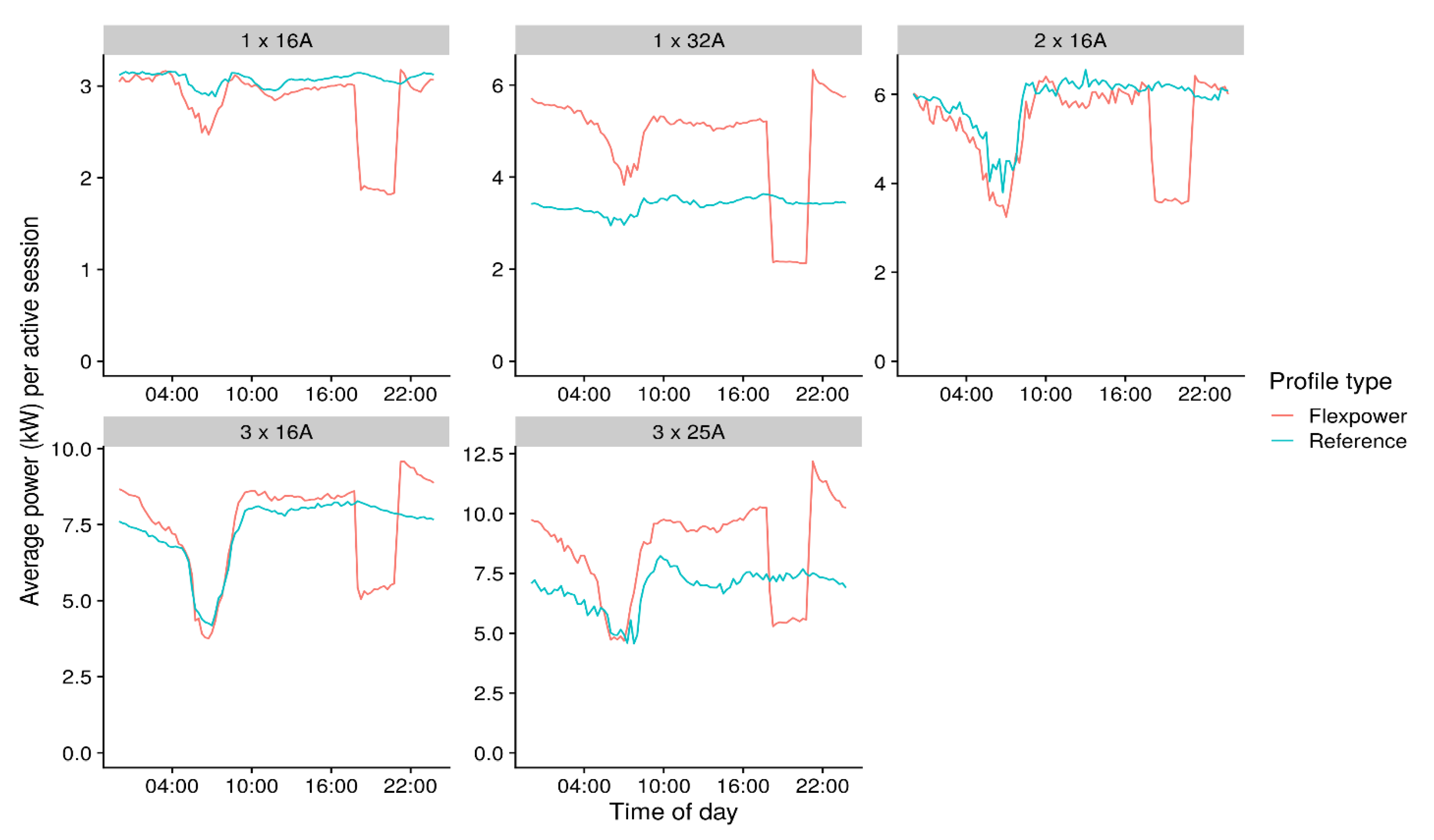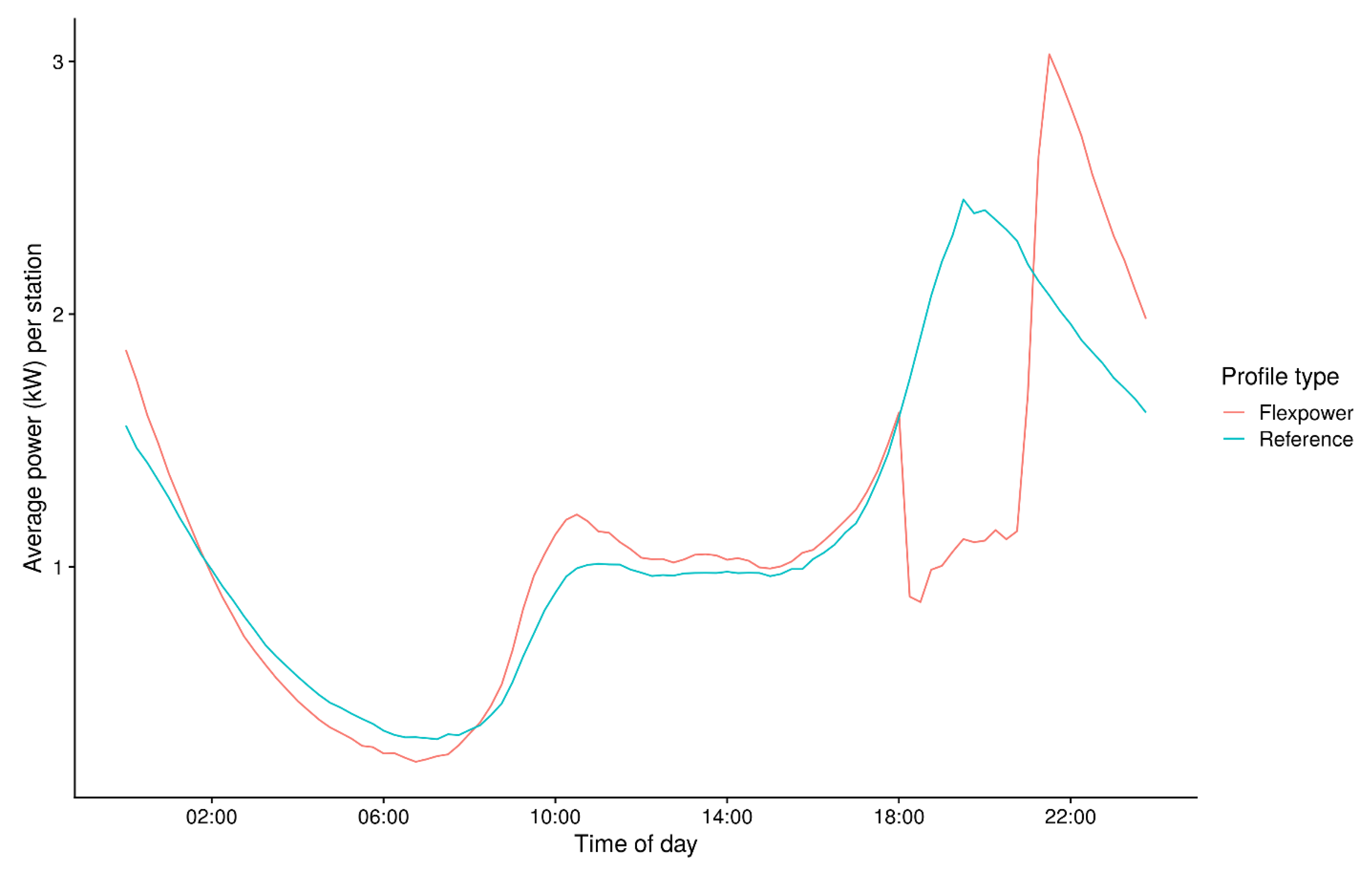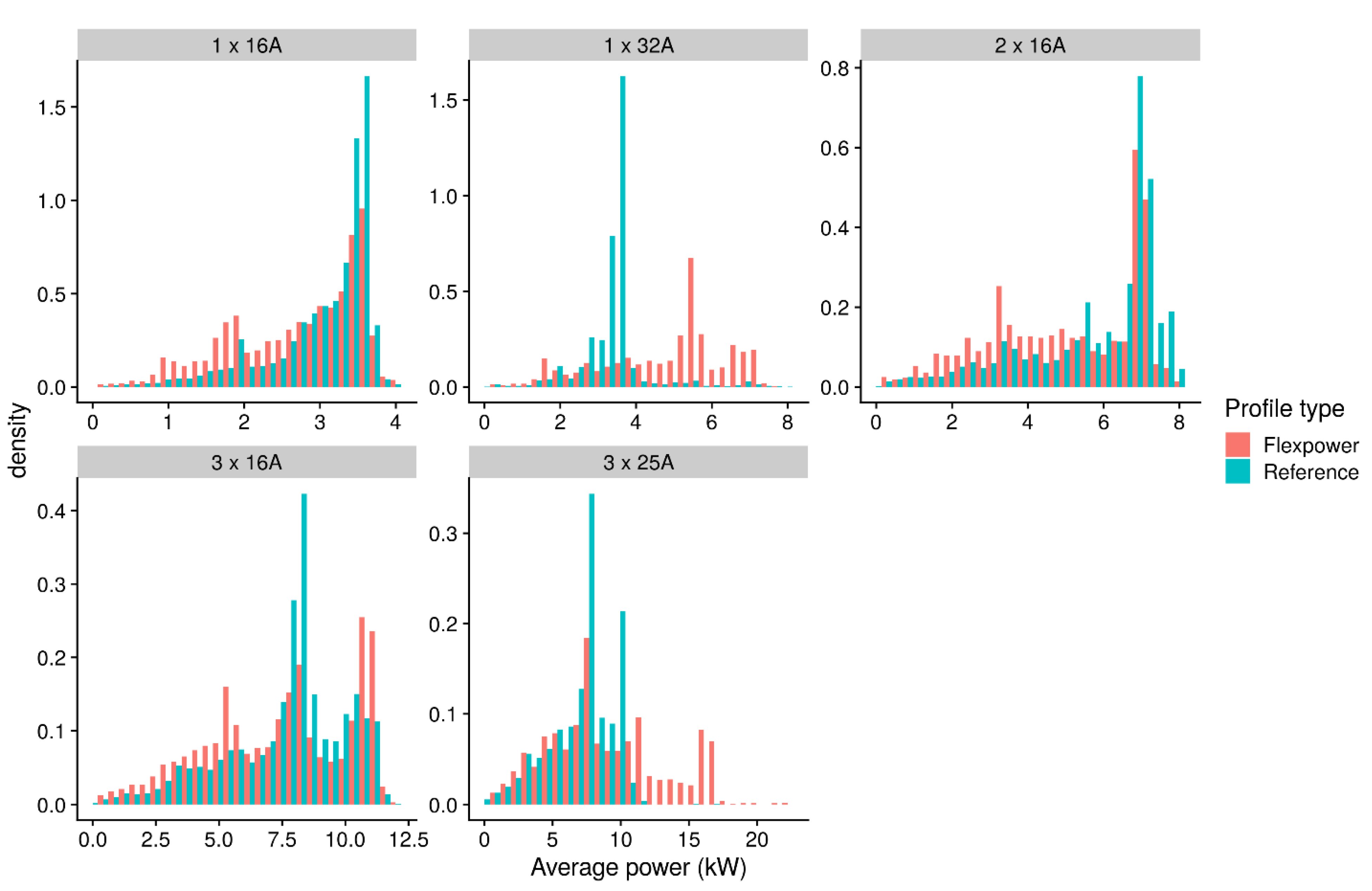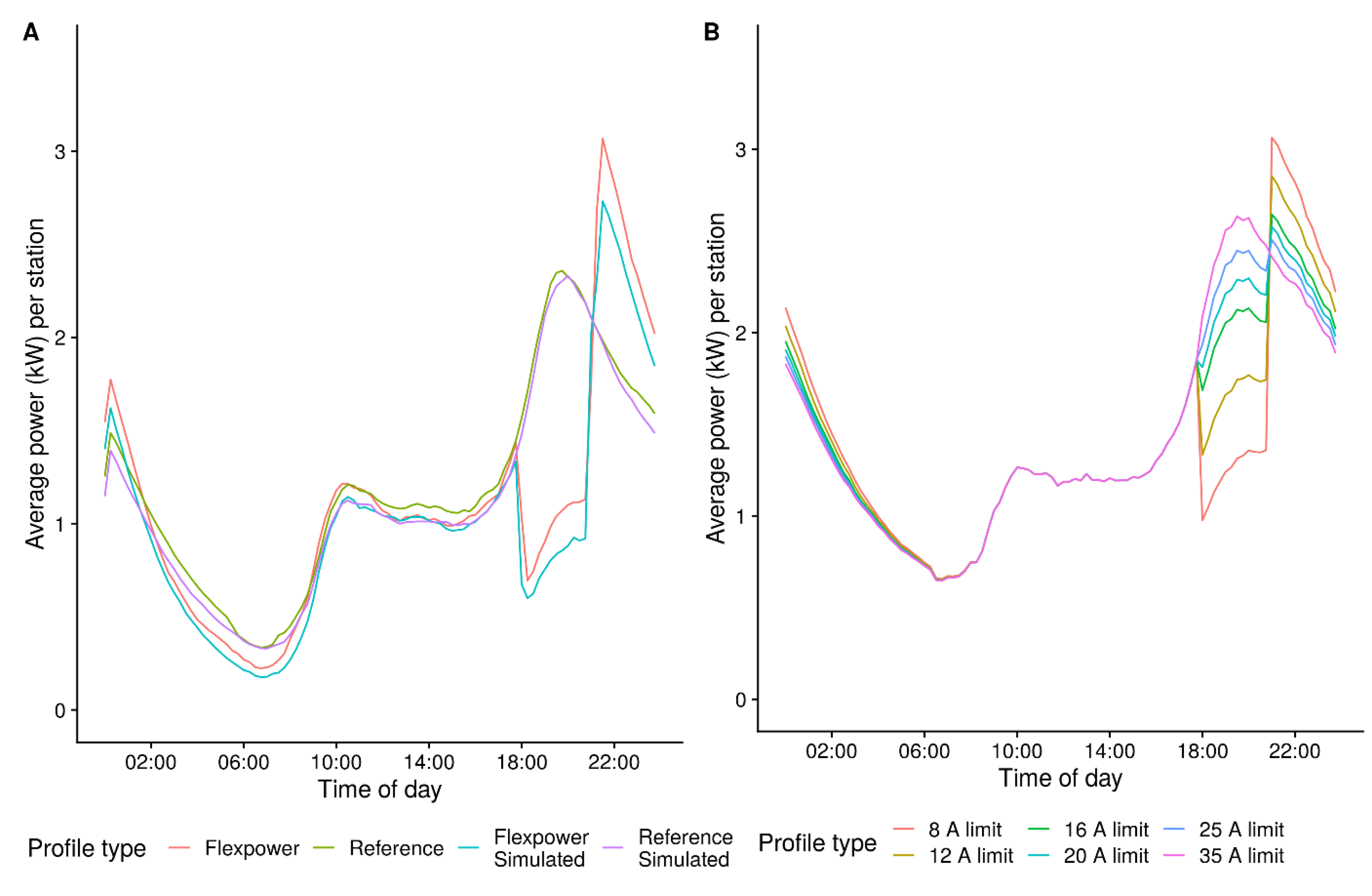Flexible Charging of Electric Vehicles: Results of a Large-Scale Smart Charging Demonstration
Abstract
1. Introduction
2. Materials and Methods
3. Results and Discussion
3.1. Average Charging Power Per Session
3.2. Total Grid Load
3.3. Positively and Negatively Affected Sessions
3.4. Solar Intensity Levels
3.5. Simulation Model
4. Outlook
5. Conclusions
Author Contributions
Funding
Acknowledgments
Conflicts of Interest
References
- Ev, I.G. Outlook to Electric Mobility; International Energy Agency (IEA): Paris, France, 2019. [Google Scholar]
- Figenbaum, E. Perspectives on Norway’s supercharged electric vehicle policy. Environ. Innov. Soc. Transitions 2017, 25, 14–34. [Google Scholar] [CrossRef]
- García-Villalobos, J.; Zamora, I.S.; Martín, J.I.; Asensio, F.J.; Aperribay, V. Plug-in electric vehicles in electric distribution networks: A review of smart charging approaches. Renew. Sustain. Energy Rev. 2014, 38, 717–731. [Google Scholar] [CrossRef]
- Galus, M.D.; Vayá, M.G.; Krause, T.; Andersson, G. The role of electric vehicles in smart grids. Wiley Interdiscip. Rev. Energy Environ. 2013, 2, 384–400. [Google Scholar] [CrossRef]
- Daina, N.; Sivakumar, A.; Polak, J.W. Electric vehicle charging choices: Modelling and implications for smart charging services. Transp. Res. Part C Emerg. Technol. 2017, 81, 36–56. [Google Scholar] [CrossRef]
- Pallonetto, F.; Mangina, E.; Milano, F.; Finn, D.P. SimApi, a smartgrid co-simulation software platform for bench-marking building control algorithms. SoftwareX 2019, 9, 271–281. [Google Scholar] [CrossRef]
- Richardson, D.B. Electric vehicles and the electric grid: A review of modeling approaches, Impacts, and renewable energy integration. Renew. Sustain. Energy Rev. 2013, 19, 247–254. [Google Scholar] [CrossRef]
- Verzijlbergh, R.A.; Grond, M.O.W.; Lukszo, Z.; Slootweg, J.G.; Ilic, M.D. Network impacts and cost savings of con-trolled EV charging. IEEE Trans. Smart Grid 2012, 3, 1203–1212. [Google Scholar] [CrossRef]
- Hildermeier, J.; Kolokathis, C.; Rosenow, J.; Hogan, M.; Wiese, C.; Jahn, A. Smart EV Charging: A Global Review of Promising Practices. World Electr. Veh. J. 2019, 10, 80. [Google Scholar] [CrossRef]
- Speidel, S.; Braunl, T. Driving and charging patterns of electric vehicles for energy usage. Renew. Sustain. Energy Rev. 2014, 40, 97–110. [Google Scholar] [CrossRef]
- Mu, Y.; Wu, J.; Jenkins, N.; Jia, H.; Wang, C. A spatial–Temporal model for grid impact analysis of plug-in electric vehicles. Appl. Energy 2014, 114, 456–465. [Google Scholar] [CrossRef]
- Sadeghianpourhamami, N.; Refa, N.; Strobbe, M.; Develder, C. Quantitive analysis of electric vehicle flexibility: A data-driven approach. Int. J. Electr. Power Energy Syst. 2018, 95, 451–462. [Google Scholar] [CrossRef]
- Yang, Z.; Li, K.; Foley, A. Computational scheduling methods for integrating plug-in electric vehicles with power systems: A review. Renew. Sustain. Energy Rev. 2015, 51, 396–416. [Google Scholar] [CrossRef]
- Quirós-Tortós, J.; Ochoa, L.F.; Alnaser, S.W.; Butler, T. Control of EV charging points for thermal and voltage management of LV networks. IEEE Trans. Power Syst. 2015, 31, 3028–3039. [Google Scholar] [CrossRef]
- Aunedi, M.; Woolf, M.; Strbac, G.; Babalola, O.; Clark, M. Characteristic demand profiles of residential and commercial EV users and opportunities for smart charging. In Proceedings of the 23rd International Conference Electricity Distribution (CIRED 2015), Lyon, France, 15–18 June 2015; pp. 1–5. [Google Scholar]
- Bauman, J.; Stevens, M.; Hacikyan, S.; Tremblay, L.; Mallia, E.; Mendes, C. Residential Smart-Charging Pilot Program in Toronto: Results of a Utility Controlled Charging Pilot. World Electr. Veh. J. 2016, 8, 531–542. [Google Scholar] [CrossRef]
- Zweistra, M.; Janssen, S.; Geerts, F. Large Scale Smart Charging of Electric Vehicles in Practice. Energies 2020, 13, 298. [Google Scholar] [CrossRef]
- Khoo, Y.B.; Wang, C.-H.; Paevere, P.; Higgins, A. Statistical modeling of Electric Vehicle electricity consumption in the Victorian EV Trial, Australia. Transp. Res. Part D Transp. Environ. 2014, 32, 263–277. [Google Scholar] [CrossRef]
- Das, R.; Wang, Y.; Putrus, G.; Kotter, R.; Marzband, M.; Herteleer, B.; Warmerdam, J. Multi-objective techno-economic-environmental optimisation of electric vehicle for energy services. Appl. Energy 2020, 257, 113965. [Google Scholar] [CrossRef]
- Geelen, D.; Refa, N.; Spiering, R. Smart charging electric vehicles based on a flexibility market. In Proceedings of the 25th International Conference on Electricity Distribution, Madrid, Spain, 3–6 June 2019. [Google Scholar]
- Bons, P.C.; Buatois, A.; Ligthart, G.; Geerts, F.; Piersma, N.; Hoed, R.V.D. Impact of Smart Charging for Consumers in a Real World Pilot. World Electr. Veh. J. 2020, 11, 21. [Google Scholar] [CrossRef]
- Quiros-Tortos, J.; Ochoa, L.F.; Lees, B. A statistical analysis of EV charging behavior in the UK. In Proceedings of the 2015 IEEE Conference on PES Innovative Smart Grid Technologies Latin America (ISGT-LA 2015), Montevideo, Uruguay, 5–7 October 2015; pp. 445–449. [Google Scholar]
- weerlive API. Available online: http://weerlive.nl/delen.php (accessed on 3 April 2020).






| Vehicle Category | Example of Model on the Market | Number of Sessions | Sessions (%) | Number of Vehicles | Vehicles (%) | Energy (MWh) | Energy (%) | Average Energy/Session (kWh) |
|---|---|---|---|---|---|---|---|---|
| 1 × 16 A | Mitsubishi Outlander (PHEV) | 42,987 | 49% | 5977 | 43% | 255.58 | 24% | 5.95 |
| 1 × 32 A | Jaguar I-Pace | 14,043 | 16% | 1654 | 12% | 221.91 | 21% | 15.80 |
| 2 × 16 A | VW e-Golf | 4965 | 6% | 800 | 6% | 59.60 | 6% | 12.00 |
| 3 × 16 A | Tesla Model 3 | 16,833 | 19% | 3632 | 26% | 352.58 | 33% | 20.95 |
| 3 × 25 A | Tesla Model S | 6065 | 7% | 797 | 6% | 155.12 | 14% | 25.58 |
| unknown | 2669 | 3% | 887 | 6% | 34.19 | 3% | 12.81 |
| Vehicle Category | Negative | No Impact | Positive | Sessions That Have Completed Charging (%) |
|---|---|---|---|---|
| 1 × 16 A | 19% | 77% | 4% | 64.7% |
| 1 × 32 A | 5% | 28% | 67% | 59.8% |
| 2 × 16 A | 23% | 77% | 0% | 62.6% |
| 3 × 16 A | 15% | 74% | 11% | 58.5% |
| 3 × 25 A | 2% | 64% | 34% | 52.9% |
Publisher’s Note: MDPI stays neutral with regard to jurisdictional claims in published maps and institutional affiliations. |
© 2021 by the authors. Licensee MDPI, Basel, Switzerland. This article is an open access article distributed under the terms and conditions of the Creative Commons Attribution (CC BY) license (https://creativecommons.org/licenses/by/4.0/).
Share and Cite
Bons, P.C.; Buatois, A.; Schuring, F.; Geerts, F.; van den Hoed, R. Flexible Charging of Electric Vehicles: Results of a Large-Scale Smart Charging Demonstration. World Electr. Veh. J. 2021, 12, 82. https://doi.org/10.3390/wevj12020082
Bons PC, Buatois A, Schuring F, Geerts F, van den Hoed R. Flexible Charging of Electric Vehicles: Results of a Large-Scale Smart Charging Demonstration. World Electric Vehicle Journal. 2021; 12(2):82. https://doi.org/10.3390/wevj12020082
Chicago/Turabian StyleBons, Pieter C., Aymeric Buatois, Friso Schuring, Frank Geerts, and Robert van den Hoed. 2021. "Flexible Charging of Electric Vehicles: Results of a Large-Scale Smart Charging Demonstration" World Electric Vehicle Journal 12, no. 2: 82. https://doi.org/10.3390/wevj12020082
APA StyleBons, P. C., Buatois, A., Schuring, F., Geerts, F., & van den Hoed, R. (2021). Flexible Charging of Electric Vehicles: Results of a Large-Scale Smart Charging Demonstration. World Electric Vehicle Journal, 12(2), 82. https://doi.org/10.3390/wevj12020082





